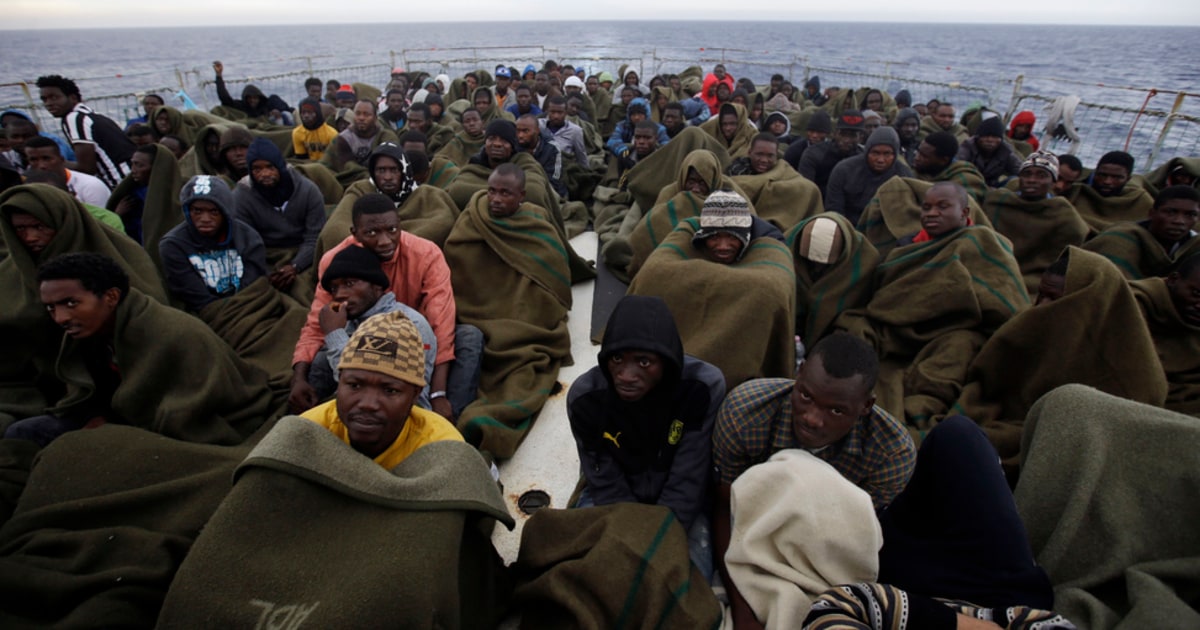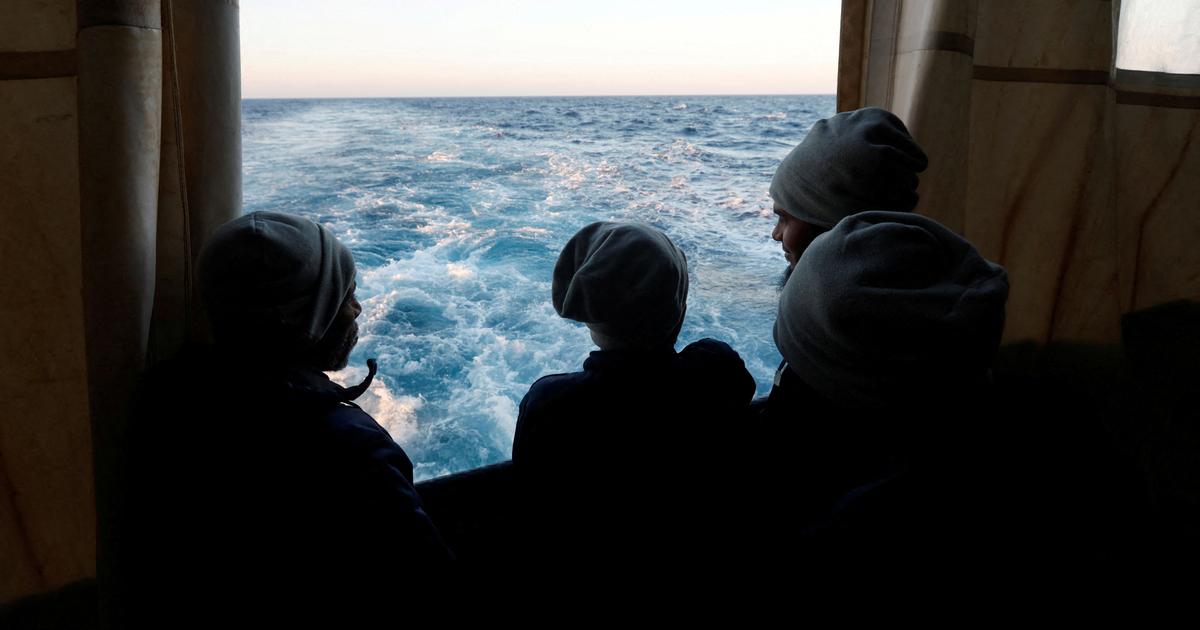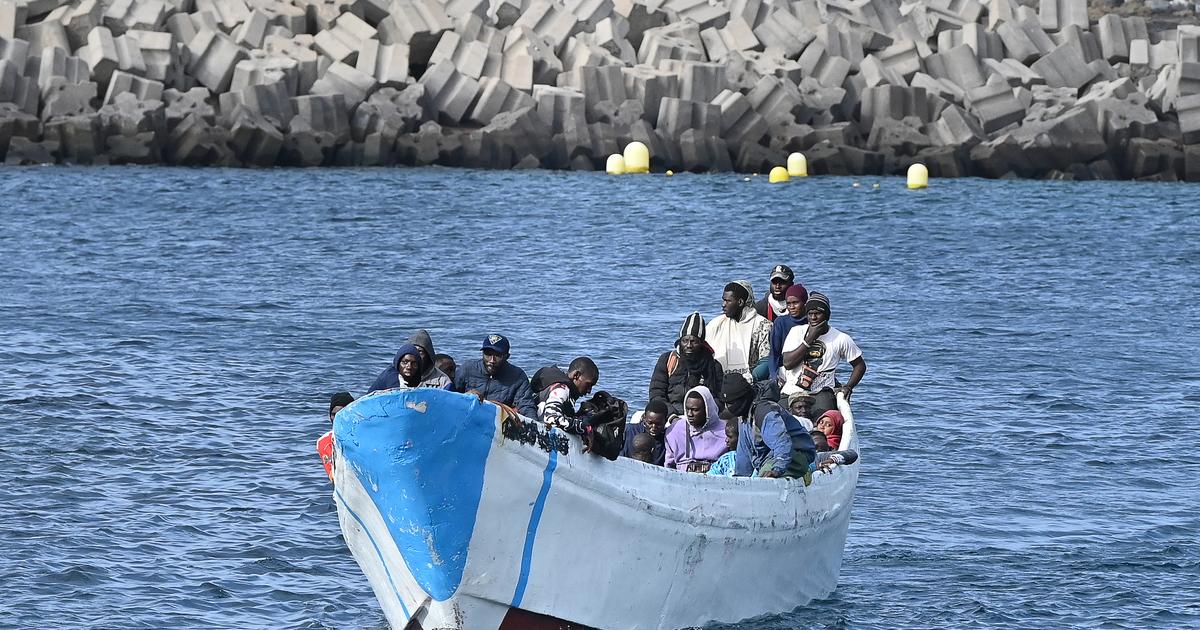Jeff Valenzuela filled in the forty labels with precision and good handwriting.
Some were yellow, others beige, and the names were repeated incessantly: María, José, Nayeli, Tomás, Felipe, Sandra, and many others.
It was a long and painful litany.
Each name reminded him of his family and friends of Mexican descent, but when he had to write other information such as the ages, the places where they were found and, above all, the causes of death, a chill ran down his spine.
“We always talk about migrants as numbers, as statistics.
But
when you write their names, how they died and how they were found, you humanize them
.
You remember that they are human beings and that moves you, ”explains Valenzuela, a 39-year-old photographer who attended the
Hostile Terrain 94
workshops
, an exhibition that opened at the Museum of Us in San Diego, California, on November 12.
Visitors to the Hostile Terrain exhibition at the Museum of Us in San Diego, California on November 13, 2021.
You could say that
Hostile Terrain 94
is an installation of participatory maps, but in reality it is a wake-up call, a cry of warning that, since 2019, is going around the world.
These are traveling exhibitions whose main purpose is to raise awareness about the vast and cruel deaths of the tens of thousands of migrants who cross the inhospitable places of the US-Mexico border in search of a better future.
"It is the same information from the official databases, but we present it in a different way so that it connects with the public that sometimes does not read books, news or does not watch documentaries, but must find out what happens with migrants", says Jason de León, UCLA anthropologist and director of the Undocumented Migration Project, an arts education and research collective that developed this project.
This has been the arduous path of the migrant caravan heading to the United States.
Oct. 26, 202103: 37
Defy nature
Hostile Terrain
, or hostile terrain, is numbered 94 in reference to "Prevention through deterrence," a US Border Patrol policy implemented in 1994 to
redirect the flow of migration to remote and dangerous regions of border.
It was believed that the harshness of brutal environments such as the Sonoran desert would deter migrants from crossing into the United States.
Statistics tell another story.
Natural barriers don't put people off: Customs and Border Protection recorded more than 1.7 million encounters with migrants in the last fiscal year.
A record that triples arrests between 2012 and 2020.
However, the most chilling figure is the 557 deaths of migrants in their attempt to reach the United States, which totals an increase of more than 50% compared to 2020.
Participants in Hostile Terrain 94 workshops in San Diego, California Museum of Us
"Many Americans do not understand what is happening in countries like Honduras or El Salvador, in fact, they do not even know how to locate Central America on a map," says De León, who has spent more than two decades doing anthropological work on migration, both in Mexico as in the United States.
[The number of immigrants detained and later released with a GPS shackle breaks a record]
Raised in McAllen, Texas, De León recalls seeing desperate people crossing the Rio Grande from the Mexican city of Reynosa in broad daylight in the 1980s.
Decades later, he perceives the same anguish in the migrants whom he interviews for his research, which has earned him international recognition and multiple awards such as the "genius scholarship" from the MacArthur program.
In fact, the idea for this artistic project arose during his fieldwork on the border where he began to find objects abandoned by migrants.
First they were bags, purses, shoes or clothes.
Then his team started coming across human remains.
De León never forgets the day he found the body of a woman who lay under the burning sun, lifeless and lifeless.
Accompanied by his team, he had to wait several hours until the authorities went to collect the remains.
Exhibition labels Hostile Terrain 94 Museum of Us
The trauma of that experience ignited his interest in the immigration issue and he did not stop investigating the woman, called Maricela, and her relatives.
The fruit of that intense work is collected in the book
The Land of Open Graves: Living and Dying on the Migrant Trail
.
"A great wall is not going to stop people at the border
because the forces that drive them to leave their countries, such as crime, poverty or climate change are much stronger," he says.
It's about exposing visitors to data that we all have to confront. "
Luisa martínez, museum of us
Tiredness begins to leave its mark on the members of the migrant caravan who are overwhelmed by the heat
Nov. 9, 202100: 23
Write about skeletons
In each venue, the exhibition mutates and incorporates new sound, graphic or audiovisual elements on migrants, but the secret of its success –translated in more than a hundred exhibitions on different continents– lies in the lasting impact of the installation.
It is a map of the state of Arizona filled with the labels, with all the available data,
of 3,200 migrants whose bodies were found under the inclement sun of the Sonoran desert
, between 2001 and 2020.
In many cases, the yellow labels are the last vestige of their lives because they correspond to the people who have not been identified, so they gather the only information that remains of them (the beige ones contain the data of the identified people).
From afar, it looks like a three-dimensional silhouette with varied textures and a repeating palette of yellow with beige undertones.
But everything changes when the viewer approaches the installation.
With every detail you understand why these people left their countries "
Luis valdez, hostile terrain 94 workshop
Luisa Martínez, curator of
Hostile Terrain 94
at the Museum of Us, still remembers her first impression when she saw the installation at an event in Washington State.
“It was a powerful moment because you get closer and you start reading all the information from people.
You see layers and layers of data, it is something very heavy, especially due to the conditions in which the bodies were found
”, explains Martínez, who details that the assembly will last two years.
It is an integral experience that precedes the assembly of the installation, with courses and workshops in which people begin to fill in the labels, and continues during the exhibition because empty spaces are left so that people who visit the museum can also write the data of some migrants.
It is a work of awareness that does not stop.
“I think it's about exposing visitors to data that we all have to confront.
We cannot forget them, ”says Martínez.
The installation was conceived so that we cannot look away from the thousands of labels, the hundreds of lives that challenge us from the map.
Immigrants arrested in multi-city protests demanding a path to citizenship
Nov. 4, 202101: 35
Luis Valdez, a 31-year-old architect, drowned in his memories while writing the exhibition labels because, between 2008 and 2009, he volunteered at a migrant shelter in San Luis Potosí, Mexico.
“I wrote the names and I began to think that I was going to recognize someone from the shelter.
Although thousands of people cross every day, I had that feeling.
Fortunately I didn't find any, ”he says with relief.
Valdez says the most difficult thing was methodically pointing out the causes of the deaths and the condition of the remains.
Little by little he deciphered the forensic jargon that, far from taking him to the territory of the dead, reminded him of the tragic humanity of the 30 labels he filled out.
Fully fleshed
, means the corpse died a day ago or less.
Skeletonized
already implies that the person passed away six or eight months ago.
Sometimes the entire skeleton is not found, and the 206 bones of the body become a grim puzzle.
Ruta Norte: border identity is a project that seeks to use virtual reality technologies to tell stories of migrants.Ruta Norte: border identity
“When you write that, everything becomes very real.
With every detail you understand why these people left their countries
and ended up dying of heat stroke, hypothermia, fatigue, dehydration and many other terrible things.
My emotional capacity reached the limit ”, he asserts.
Migrants helping migrants
More than 1,000 kilometers away, and on the other side of the border, another artistic project focuses on a different aspect of the migratory experience.
Northern Route: Border Identity
uses virtual reality to bring visitors to the Ciudad Juárez Museum of Art closer to the personal experience of migrants who, for various reasons, are in Mexico.
“Through immersive technologies we seek to position viewers at the center of the story, that is, they put on virtual reality goggles and
these migrants appear
and
begin to tell them about their journeys,
how they arrived in Mexico and many details of their lives, ”explains Jonathan Alexander Herrera, the filmmaker who created this project together with Liz Pasillas, a Mexican producer and documentary filmmaker.
Herrera is no stranger to the immigration experience.
Venezuelan by birth, and from Juárez by adoption, he explains that he left his country almost 20 years ago when things were very different.
“I arrived in Mexico by plane, I did not go out walking along trails, and crossing those many countries as we see now.
But I always felt the need to tell the stories of people who leave everything behind to emigrate, ”he vehemently asserts.
I fight for immigrants because when they violate the rights of one of them, it is as if they were violating me. "
ernesto vasconcelos, north route
By October 2021, the United Nations estimated that there were
more than 5.9 million refugees and migrants from Venezuela in the world.
The story of Ernesto Vasconcelos, a Venezuelan migrant who arrived in Mexico after multiple hardships and persecutions in his country, and who now dedicates himself to legally advising other migrants, is one of the cases that were selected for
Ruta Norte.
“I fight for immigrants because when they violate the rights of one of them, it is as if they were violating them,” explains Vasconcelos during the narration of his life.
Showing the contributions of the migrant community in Mexico is one of the vertices of this project.
The story of Susana Coreas, a Salvadoran trans woman, is another of the testimonies that visitors to the Juárez museum will be able to learn.
Deportations of Central Americans on the US-Mexico Border on the Rise
Nov. 14, 202102: 16
Although she now lives in the United States, Coreas founded Casa de Colores, a shelter for people from the LGBTQ + community, during her stay in Ciudad Juárez.
“It all came out of need, but seeing that volume of support was something that hadn't happened to me.
I had never felt that kind of acceptance,
”he explains with emotion during the account of his experience.
By using virtual reality headsets, people not only experience new landscapes and auditory sensations, what is more impressive is knowing first-hand the circumstances and vicissitudes that made these people make the decision to undertake a long journey that changed their lives .
It's like putting yourself in someone else's shoes, explains Luis Chaparro, a journalist specializing in migration who has interviewed dozens of foreigners during their time in the country.
“You put on your glasses and you are immersed in
that experience that gives you a different dimension of reality, it
is something that surpasses texts and videos.
The backgrounds, the sounds, transport you to those real stories that are so strong, but that we see every day at the border, ”concludes Chaparro.















